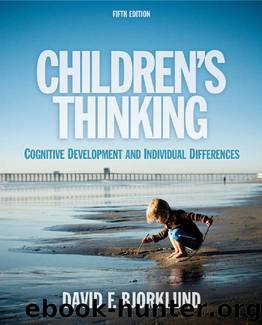Children's Thinking, 5th ed. by David F. Bjorklund

Author:David F. Bjorklund [Bjorklund, David F.]
Language: eng
Format: epub
Published: 0101-01-01T00:00:00+00:00
Some Theoretical Perspectives of Language Development 375
to these areas produces specific language impairment. For example, damage to
Wernicke’s area, located in the temporal lobe, results in problems comprehending
speech, although the ability to produce speech is not usually affected. Damage to
Broca’s area, located in the frontal lobes, usually results in problems with speech pro-
duction. As I mentioned in Chapter 2, when these areas are damaged in infancy or
early in childhood, recovery of language function is often good, and much better than
when damage occurs later in life, especially after adolescence (Kolb & Whishaw,
1990; Stiles et al., 2005).
Advances in neuroimaging technologies have permitted scientists to examine how
the brain operates when it processes language and, important from our perspective, to
look at the neurological basis of language development. For example, Figure 9-5 (from
Sakai, 2005) presents two views of the left hemisphere in an adult. Figure 9-5A identi-
fies areas of the brain associated with phonology, semantics, syntax, and sentence
comprehension. Other areas of the brain are also involved in language processing,
but the areas identified here are domain-specific areas, as hypothesized by nativist the-
orists, specialized for particular types of language processing. Figure 9-5B shows what
Kuniyoshi Sakai (2005) has termed the grammar center. The frontal lobe has areas
that are specifically related to processing grammatical information. Although these
areas are also involved in other types of processing, they appear to represent a
domain-specific neural system dedicated to syntactic processing. For instance, Ryuichiro
Hashimoto and Sakai (2002) reported that activation of the grammar center was found
only when people made syntactic decisions (for example, is a sentence grammatical
or not?); activation was not found during tasks involving verbal short-term memory
F I G U R E 9-5
Two views of the left hemisphere. Figure A shows possible networks for various language func-
tions. Figure B shows the grammar center and other areas involved in language, as proposed by
Sakai (2005). The green area is selectively involved in comprehending sentences. The red areas
are specifically involved in syntactic processing and can be regarded as the grammar center.
Source: Sakai, K. L. (2005). Language acquisition and brain development. Science, 310, 815–919. Reprinted with permission from AAAS.
376 CHAPTER NINE • Language Development
(for example, recalling a list of words in exact order). This and related work led Sakai
(2005) to conclude that “the human left frontal cortex is thus uniquely specialized in
the syntactic processes of sentence comprehension, without any counterparts in other
animals” (p. 817).
Do children or infants display this same neurological specialization for language?
Perhaps not surprisingly, there has been much less neuroimaging research with chil-
dren than with adults, making it difficult to provide any definitive answer to the ques-
tion of when such hemispheric specialization begins. However, research has shown
that even the hemispheres of newborns are different, or lateralized. For example, neo-
nates show greater electrical activation to language in the left than in the right hemi-
sphere, while music and other nonlanguage sounds show the opposite pattern
(Molfese & Molfese, 1980, 1985). More recent research has shown that children’s
brains are especially sensitive to language and that different parts of the brain, in addi-
tion to those used to process language in adults’
Download
This site does not store any files on its server. We only index and link to content provided by other sites. Please contact the content providers to delete copyright contents if any and email us, we'll remove relevant links or contents immediately.
The Art of Coaching Workbook by Elena Aguilar(50880)
Trainspotting by Irvine Welsh(21490)
The Secret History by Donna Tartt(18815)
Twilight of the Idols With the Antichrist and Ecce Homo by Friedrich Nietzsche(18480)
All the Missing Girls by Megan Miranda(15509)
Cat's cradle by Kurt Vonnegut(15158)
Ready Player One by Cline Ernest(14499)
Talking to Strangers by Malcolm Gladwell(13197)
Fangirl by Rainbow Rowell(9073)
The remains of the day by Kazuo Ishiguro(8794)
The Compound Effect by Darren Hardy(8790)
Thirteen Reasons Why by Jay Asher(8771)
Tools of Titans by Timothy Ferriss(8193)
Periodization Training for Sports by Tudor Bompa(8145)
Wonder by R. J. Palacio(7977)
The Lover by Duras Marguerite(7807)
A Court of Wings and Ruin by Sarah J. Maas(7627)
Change Your Questions, Change Your Life by Marilee Adams(7614)
The Complete Stick Figure Physics Tutorials by Allen Sarah(7292)
